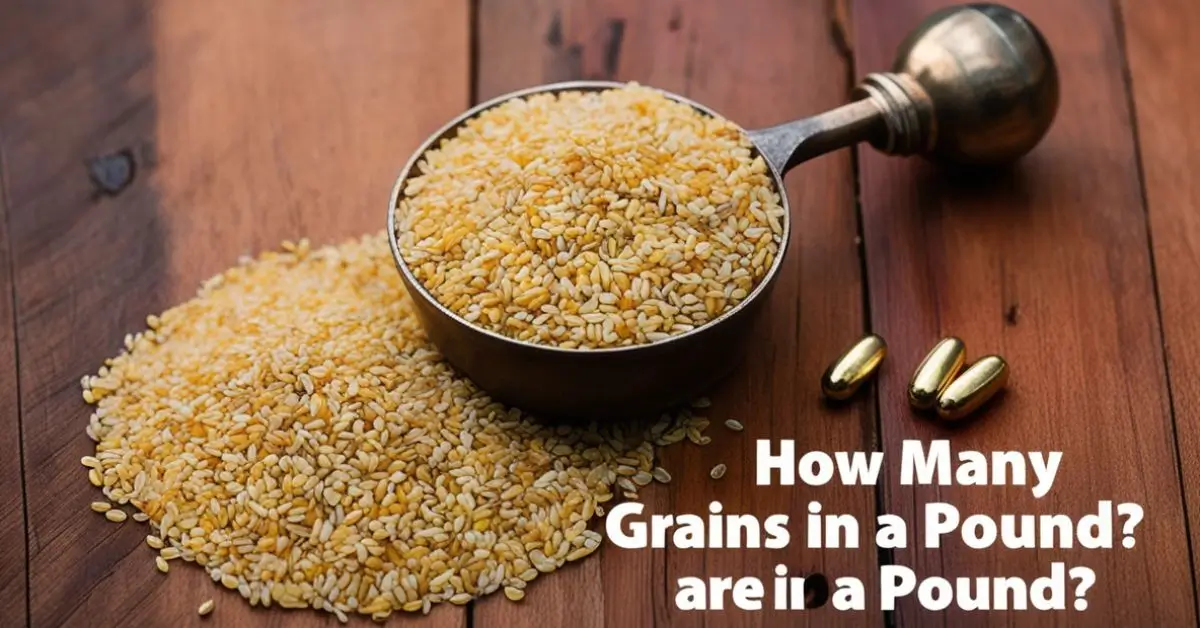Understanding the conversion between grains and pounds is essential for precision in many industries, including agriculture, ammunition reloading, and pharmaceuticals. This ancient measurement system may seem obscure to some, but its relevance continues in modern applications. So, how many grains are in a pound?
The simple answer is 7,000 grains per pound. This precise number is foundational for anyone dealing with measurements requiring extreme accuracy. But to truly grasp its significance, let’s dive deeper into the history, practical uses, and conversion techniques for grains and pounds.
The Grain: An Ancient Unit of Measurement
The grain is one of the oldest units of measurement still in use today. It originated from the approximate weight of a single grain of barley, a crop common in ancient trade and agriculture. Over time, the grain was standardized as part of the avoirdupois system, which governs most weight measurements in the United States and other countries.
One grain equals approximately 0.0648 milligrams, making it a minuscule but critical unit for measurements requiring precision.
Applications of Grain and Pound Measurements
1. Ammunition Reloading
In the world of ammunition and firearms, precision is critical. Powder measurements are often expressed in grains to ensure consistency and safety. For example, when reloading ammunition, understanding that one pound of gunpowder equals 7,000 grains allows reloaders to calculate how many cartridges they can produce.
For instance:
- If a specific cartridge requires 25 grains of powder, you can load 280 cartridges from one pound of powder.
- For heavier loads requiring 50 grains of powder, you can load 140 cartridges from the same pound.
This level of precision is vital not only for performance but also for ensuring safety in firearm use.
2. Agricultural Measurements
In agriculture, grains are used as a unit for measuring seeds and produce. Farmers dealing with bulk quantities of grains like wheat or barley benefit from understanding how grains translate into pounds. This knowledge ensures accurate pricing and distribution, especially in industries where small deviations can lead to significant financial impacts.
For example:
- A farmer selling seeds in bulk may need to calculate how many pounds of product are required to match a client’s request in grains.
- Understanding the grain-to-pound relationship helps minimize errors and enhances the efficiency of trade.
3. Pharmaceutical Applications
Pharmaceuticals often require extremely precise dosages of compounds. In such cases, grains are used as a measurement to ensure uniformity and efficacy. For example, certain tablets and medical powders are weighed in grains to ensure their active ingredients are consistent.
Practical Examples of Grain-to-Pound Conversion
To better understand the relationship, here’s a practical breakdown:
| Grains (gr) | Pounds (lb) |
|---|---|
| 1 | 0.000142857 lb |
| 10 | 0.00142857 lb |
| 100 | 0.0142857 lb |
| 1,000 | 0.142857 lb |
| 7,000 | 1 lb |
This table simplifies conversions, whether you’re working with small quantities or large batches.
The Mathematics Behind the Conversion
The calculation to convert grains to pounds is straightforward. To determine the weight in pounds:
Weight in pounds = Number of grains ÷ 7,000
For example:
- 500 grains: 500÷7,000=0.0714 pounds500 \div 7,000 = 0.0714 \, \text{pounds}500÷7,000=0.0714pounds
- 2,000 grains: 2,000÷7,000=0.2857 pounds2,000 \div 7,000 = 0.2857 \, \text{pounds}2,000÷7,000=0.2857pounds
Similarly, to convert pounds to grains:
Weight in grains = Pounds × 7,000
For example:
- 0.5 pounds: 0.5×7,000=3,500 grains0.5 \times 7,000 = 3,500 \, \text{grains}0.5×7,000=3,500grains
- 2 pounds: 2×7,000=14,000 grains2 \times 7,000 = 14,000 \, \text{grains}2×7,000=14,000grains
These calculations are particularly useful in fields where minute weight adjustments can have a significant impact.
Historical and Cultural Significance
The grain measurement has deep historical roots. It was widely used in ancient trade and remains a part of the English weight system today. While many modern industries rely on the metric system, grains persist as a unit of choice in specific niches.
For example:
- In medieval times, grains were used to standardize coin weights, ensuring fairness in trade.
- Archery enthusiasts and hunters use grains to measure the weight of arrows, ensuring they fly accurately and hit targets with the desired force.
This enduring relevance highlights the versatility and practicality of the grain as a unit of measurement.
Grains and Other Weight Systems
Grains are not confined to the avoirdupois system. They also play a role in troy and apothecaries’ weight systems.
- Troy Weight:
- Used primarily for precious metals like gold and silver.
- One troy ounce equals 480 grains, making it slightly different from the avoirdupois ounce.
- Apothecaries’ Weight:
- Used historically in pharmacy.
- One apothecaries’ dram equals 60 grains, and one ounce equals 480 grains.
Understanding these systems is crucial for professionals working in industries that intersect with historical or international measurement standards.
Modern Tools for Conversion
In today’s digital age, manual calculations aren’t always necessary. Several online tools and mobile apps simplify grain-to-pound conversions. These tools are particularly useful for those handling large quantities or needing quick calculations on the go.
Why Accuracy Matters
Precision in weight measurements is more than just a matter of convenience. In fields like reloading and pharmaceuticals, inaccuracies can lead to dire consequences, such as:
- Malfunctioning ammunition or firearms.
- Incorrect dosages of medications.
For these reasons, professionals rely on the grain as a trusted unit of measurement.
Visual Learning Resources
For those who prefer visual learning, several videos are available online that explain the relationship between grains and pounds. These resources provide step-by-step instructions and practical demonstrations, making the concept more accessible.
Conclusion
Understanding the relationship between grains and pounds is vital for precision in numerous fields. Whether you’re reloading ammunition, working in agriculture, or dealing with pharmaceuticals, knowing that one pound equals 7,000 grains ensures accurate calculations and enhances efficiency.
By mastering this simple yet powerful conversion, you can confidently handle tasks that require exact measurements, making you more effective in your field.












